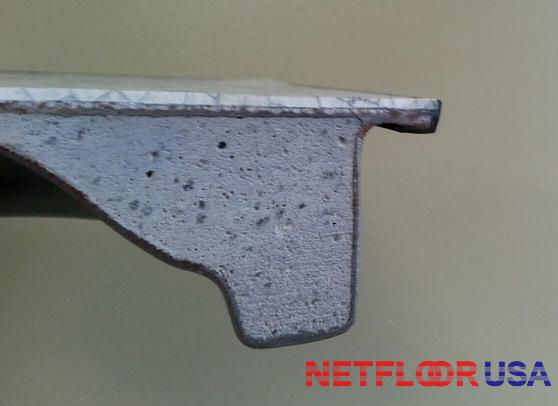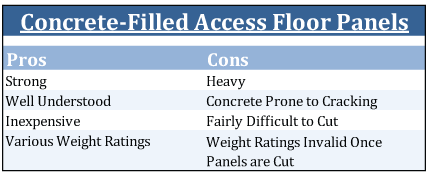Raised access floor panels weren't always a thick sandwhich of steel and concrete!
As a matter of fact, these panels were originally made of metal only. The metal was very thick, but it was strong.
Strong and expensive.

(Note: In all honesty, this was before my time, but I would welcome any comments or suggestions from anyone who has more detail. Note, though, that this goes back 40+ years!)
Concrete turned out to be a pretty good filler. It certainly was less expensive than metal. But concrete-filled raised floor panels do have problems of their own.
(Note: We manufacture and sell panels with concrete in the middle, so in an effort for "full disclosure", I won't be mentioning any specific brands. Some of the items I will mention are general industry trends that are not specific to any single brand. I've always felt that customers should have all the facts, whether they're good or bad.)
Still, there was a definite switch from all-steel panels to "cementitious" filled panels. And despite the reasons given at the time, it really came down to a single reason the switch was made.
But first, a look at cement-filled floor panels and a few of the pros and cons:
Strong Vs. Heavy
There is a correlation between being heavy and being strong. Not always causation, but there is often a definite relationship. Heavy does not always mean something is strong, but it does mean it has greater mass than something lightweight, and mass can imply strength as well as damping properties.
Oddly enough, that weight can turn out to be a drawback in many circumstances. It makes the panels harder to handle, whether that's during initial installation, or years down the road when your IT department has to re-route wires and cables, and they have to lift panels to do it.

The New Mother Nature's Taking Over
Looking around your facility, the last thing you want to think about is when the day comes that it won't be there anymore, and all that equipment has to get trashed, or reused.
What really happens to everything when the people have moved to another office? Where do the desks go? What about the computers? What about the raised floor? Most of these items aren't reused.
Trust me, there are warehouses full of old raised floor, waiting for a new owner. There isn't always something wrong with the floor; it might be dirty, scratched and banged up a little, but it still has a lot of life left in it.
But most construction projects do go with all new materials. So there is a glut of used raised flooring just sitting around, doing nothing. Some of it might find a happy home one day, but some of it is just taking up space.
Another drawback of access floor panels that are filled with concrete sandwhiched between two pieces of steel, is that they are hard to recycle.
But there is another, darker reason why there is so much used product sitting around.
Weight Rating: Concentrated, Uniform, Ultimate & Rolling
Wow, that's a long title! What does it all mean? You just want to know the floor is strong enough to hold the amount of weight you plan to put on it, without cracking or breaking.
And when it comes to concrete panels, it's the cracking that can get you in trouble. The strength of an access floor panel is a complex topic that rightly deserves its own article, or even its own engineering handbook. But for our purposes, let's quickly just focus on the fact that concerete has a crystalline structure that can easily crack when exposed to forces it wasn't designed to withstand.
If you overload a floor panel, from rolling heavy equipment across it or placing something heavy on it over time, the steel in the panel can withstand those forces more readily than the concrete. The concrete can easily fracture and lose its strength.
Brass Tacks
So, just why did the industry move away from all steel floor panels to concrete-filled panels?
Somewhere along the way, someone decided the panels cost too much. Maybe they cost too much to produce, or maybe the price was too high for the market to bear. But the decision was made to reduce the amount of metal in the panels, and make the difference in mass and strength up with concrete.
Luckily, there are more options these days: All-steel panels, concrete panels, wood core and even polycarbonate panels. Which type of flooring system is best really depends on your specific needs.
If there is one thing I hope you will remember is that: please, don't buy into the "one size fits all" game. Your building, your applicaiton is unique, and there is an access floor system that will work best for you and your organization.
Access Floor,
Netfloor USA Staco,
Seismic



 Facebook
Facebook Twitter
Twitter Google+
Google+ LinkedIn
LinkedIn